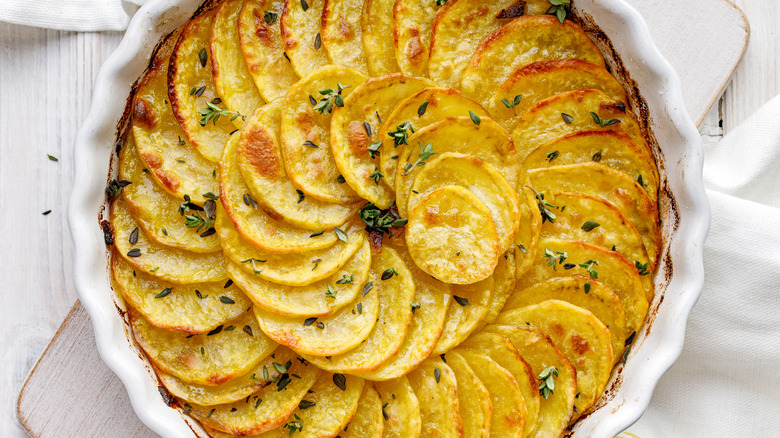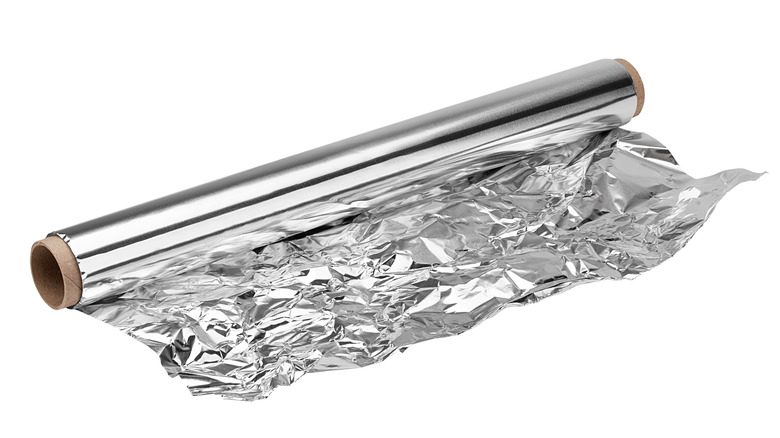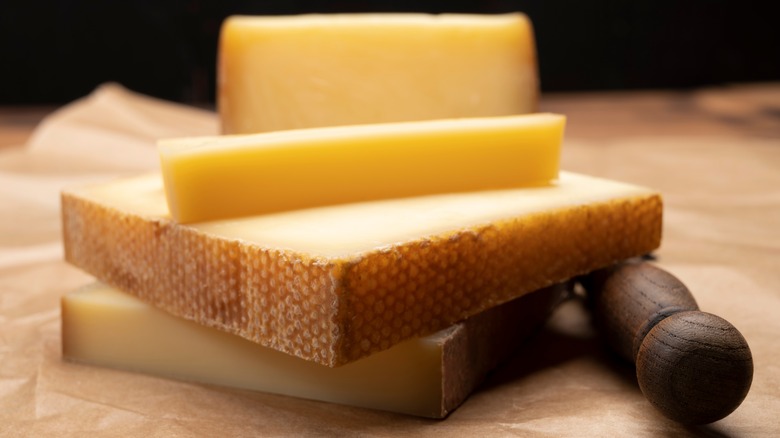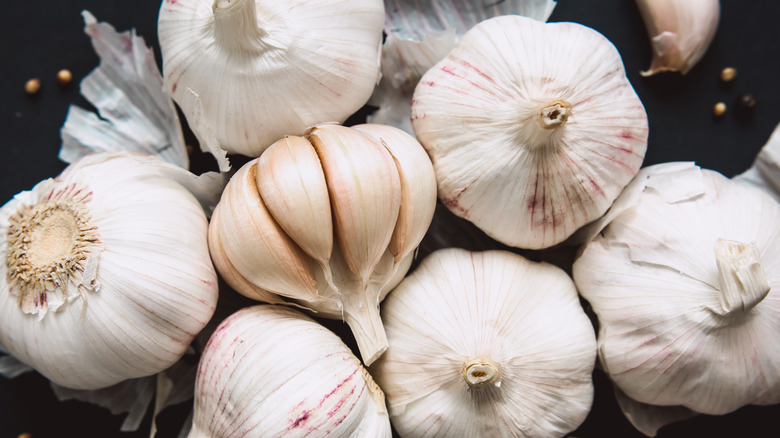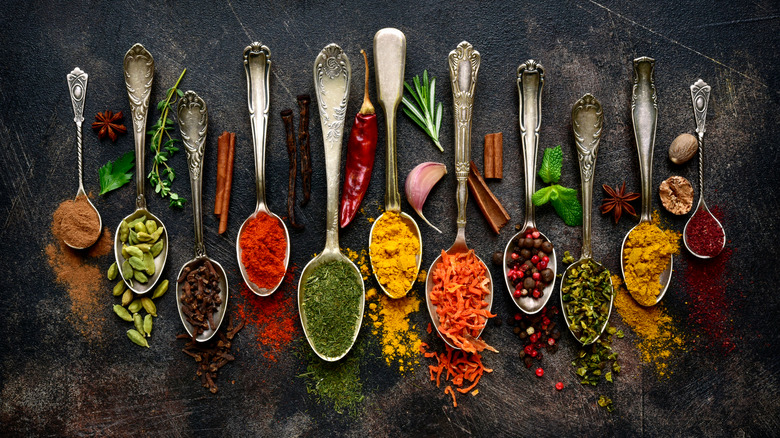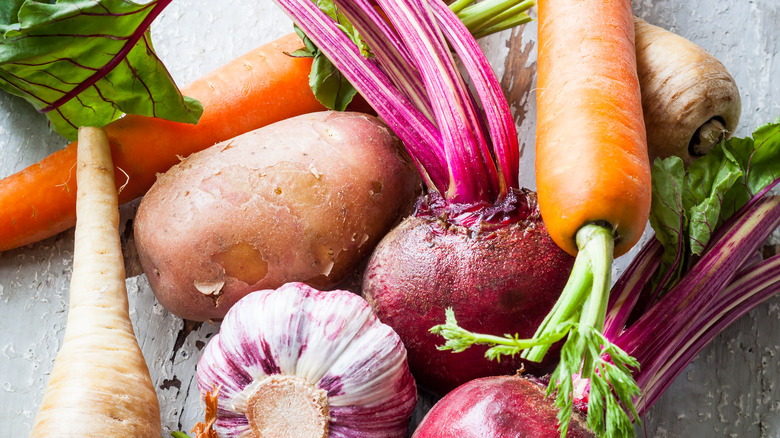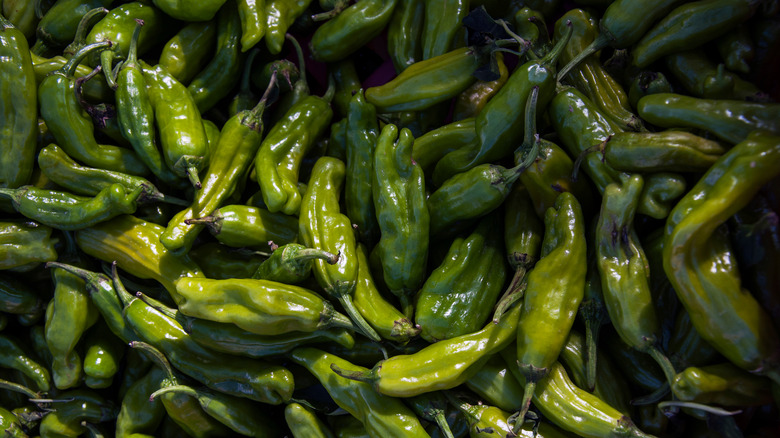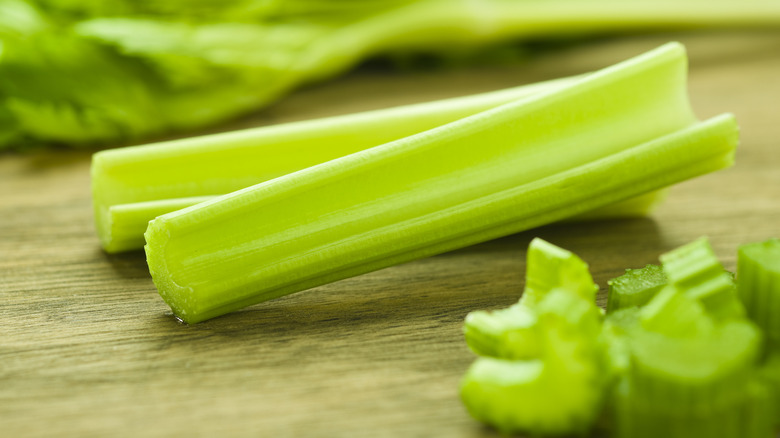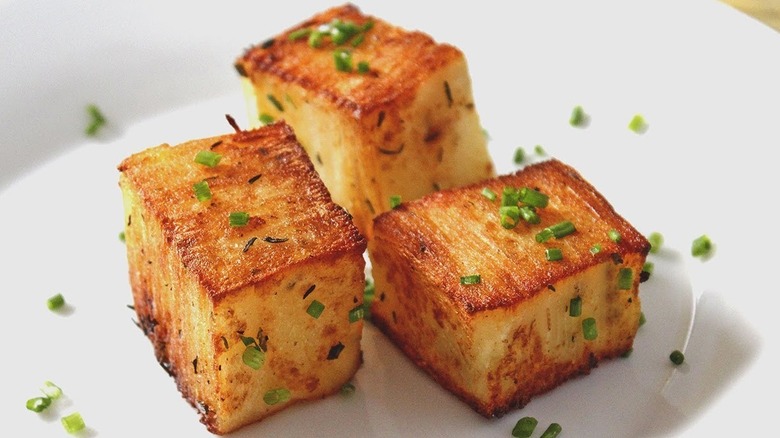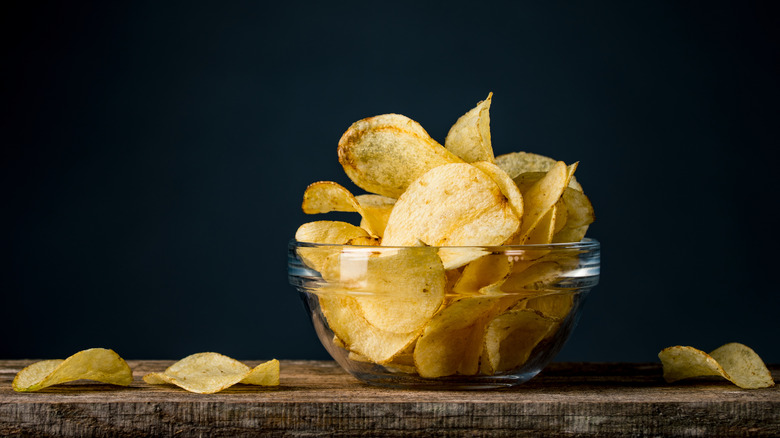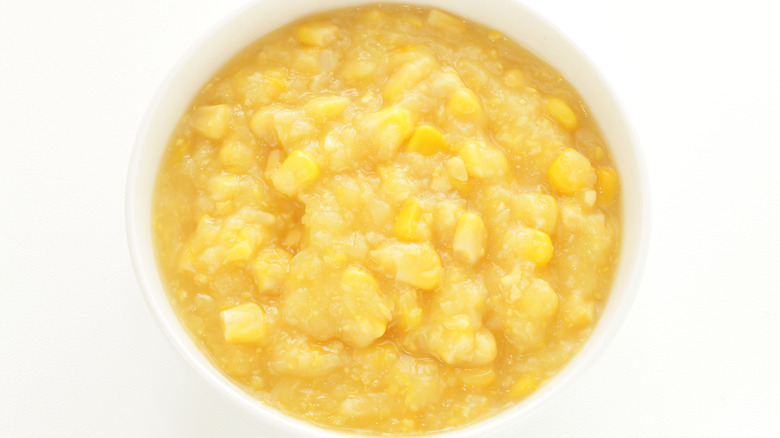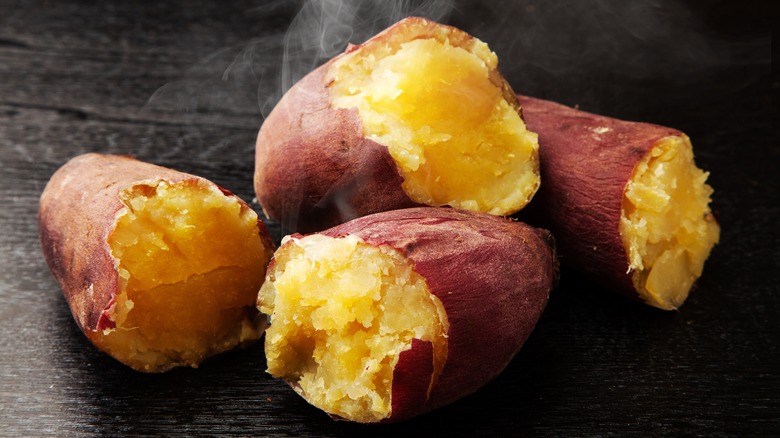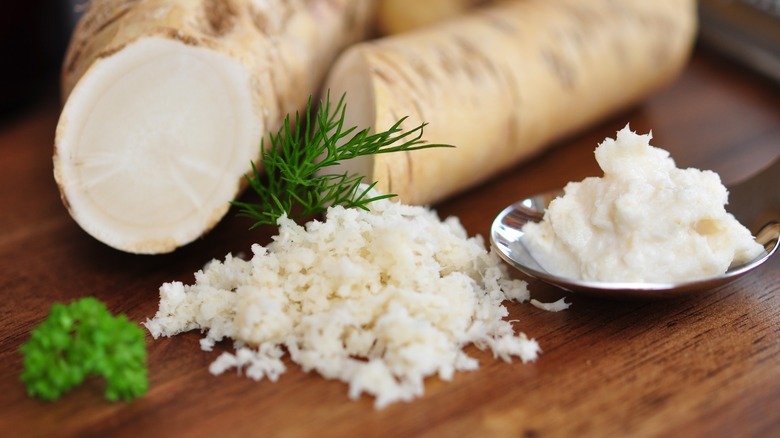12 Ways To Add More Flavor To Scalloped Potatoes
Scalloped potatoes instantly invoke comfort. It's a wholesome dish that's hearty, cheesy, and possibly sleep-inducing if you over-indulge — and rest assured, it's hard not to go back for seconds. Although the dish's origin is unknown, it's composed of all the ingredients found in French au gratin potatoes except cheese and breadcrumbs. It's a casserole that features thinly sliced potatoes layered in rows and is baked with whole milk and a butter-infused blend of garlic, onion, vegetable stock, salt, and black pepper. In other words, it's a carb-filled comfort classic that's simple to make and guaranteed to keep you and your family happily fed.
Those humble, readily available, and affordable ingredients are what make scalloped potatoes such a popular dish for dinner. The prep time is also perfect for parents who are trying to balance their work and home life — all you need is 15 minutes, and you can let your oven handle the rest. As if it wasn't crave-worthy enough, people have discovered all sorts of ways to make scalloped potatoes more delicious. From savory mix-ins to lesser-known cooking techniques, use these tips to put a new-age twist on an old-fashioned taste.
1. Use tin foil when baking for concentrated flavor
Potatoes are notoriously known for taking a long time to cook through. From boiling to air frying, many methods have been invented to reduce the cooking time. For fluffy and flavorful 'tates, tin foil is one of the best cooking tools. Use it to take scalloped potatoes to the next level. Along with trapping heat, tin foil helps the ingredients to fuse harmoniously, which brings more deliciousness out of each component. It also prevents the top layer of your scalloped potatoes from burning.
To add a lovely golden brown to the top layer, many recipes suggest removing the tin foil about a third of the way through the baking process. A baked upper crust adds the perfect toasted touch, serving as a crispy introduction to a crave-worthy experience. When you open the oven and the steamy aroma of potato-y decadence hits your nose, you'll be thanking us. Also, rather than discarding the foil, you can reuse it to store leftovers with, and when you're ready to heat it up, you can toss it right back into the oven.
2. Cheese-ify your scalloped potatoes with gruyère
As mentioned, scalloped potatoes are eerily similar to au gratin potatoes. The main difference is the addition of cheese and/or breadcrumbs. As culinary doppelgangers, many of the same flavor-boosting ingredients that are used in au gratin can also be used to spruce up scalloped potatoes. Cheese lovers will fawn over gruyère-infused scalloped potatoes, it's an indulgent excursion worth experiencing. Gruyère comes from Switzerland and has a mild nutty flavor with a creamy texture that becomes succulent and velvety when cooked. It's the centerpiece of au gratin potatoes and comparable to American Swiss and gouda.
If you're looking to cure your cravings on a cozy night, look no further than gruyere scalloped potatoes. While it won't win you any points in the health department, it's sure to satisfy your appetite every time. Incorporate gruyère by grating it first, then sprinkle some over the first layer at the halfway mark of the baking pan, followed by another layer on top. Place the pan in the oven, go watch an episode of your favorite show, and in 45 to 50 minutes it'll be ready to enjoy. Prepare to dive into a cheesy potato pool of tastiness.
3. Pre-cook garlic for less acidity
Garlic is a powerful ingredient. It has a larger-than-life personality that is magical in moderation but can quickly become overbearing. It's the ingredient that gives scalloped potatoes piquant, savory, and aromatic notes. Not only does the amount you use impact the dish's overall taste but how you prepare the garlic does too. According to Healthline, fresh garlic can trigger heartburn and even acid reflux in some people. That's why we recommend cooking garlic first, before adding it to your scalloped potatoes. Doing so tempers the acidity and allows it to complement the flavor profile better. Removing acid helps to prevent the milk from curdling as well. Curdling is great for making cheese, but disastrous for scalloped potatoes.
Pre-cooking garlic takes only a few minutes; you can also use charred garlic as a smokey and savory substitute. Cook whole cloves or chopped garlic in a small saucepan with oil until the aromatics intensify, it should take no more than 5 minutes. For a recipe that serves six, you only need three crushed garlic cloves. If you love food with an extra garlicky punch, we won't judge you if you decide to crush a couple more.
4. Season each layer for a more flavorful dish
Along with quality ingredients, the perfect seasoning blend is key to cooking good food. A seasoning blend is a culinary symphony. It's like inviting spicy, savory, herbaceous, citrusy, and earthy to dinner, but first, making sure that the seating arrangement is perfect. As a casserole-style dish, scalloped potatoes are all about carefully layering ingredients. Evenly distributing them ensures that the seasoning blend reaches the entire dish. Potatoes must be cooked for long periods to fully absorb flavor. You'll get the flavor you want and more by seasoning each layer of your scalloped potatoes.
First, start by adding your sliced potatoes to the baking pan until they reach just below the halfway mark. Sprinkle the first layer of seasoning then pour the milk mixture to the halfway mark. Next, repeat the same steps once more. You should be able to fit two potato layers into the baking pan. Now, with the scalloped potatoes fully seasoned and ready to go in the oven, your tummy will be humming a happy tune in no time.
5. Root vegetables add more flavor and nutrients
Beyond traditional scalloped potatoes, there are many ways to add your own flavorful flare. Balance this creamy concoction of starch and dairy with other nutritious root vegetables. From carrots and parsnips to beets and sweet potatoes, experiment with all sorts of combinations. Parsnips, for example, have an earthy, subtly sweet taste, with a peppery touch and hints of cinnamon and licorice. Pairing it with scalloped potatoes will add sweetness. Along with sweet and delicious satisfaction, you'll also benefit from the fiber, vitamins, and micronutrients found in parsnips.
Get to the root of flavor and put some beets into your scalloped potatoes. According to Healthline, consuming beets can improve heart health, lower blood pressure, and potentially increase your overall endurance. It's the perfect performance fuel for athletes, and will definitely zap your hunger pangs away in a jiffy. When adding root vegetables, make sure to slice them as thinly as the potatoes. That way they'll cook at the same pace and have the same consistency. The colorful vegetables can be arranged in a visually appealing design too, and believe us, the presentation will only enhance the experience.
6. Turn up the heat with canned green chiles
Cozy and crave-worthy, scalloped potatoes are one of the best comfort foods for chilly winter nights. Take it to new levels of comfort by adding canned hatch green chiles. Zesty with a mild spicy kick, hatch green chiles are a staple Mexican ingredient. In fact, more than 58,000 tons were grown in Hatch, New Mexico last harvest. It's considered one of the state's official vegetables and is even featured on the license plate. Clearly, these green piquant veggies aren't ordinary chiles.
Spice-wise, they're subtle rather than overpowering and have a smokey and vegetal taste. The kick is akin to raw onion, rather than peppery. Roasted hatch green chiles are more mellow and creamy. When added to scalloped potatoes, you'll get the savory satisfaction of the traditional ingredients, with the added earthy boost of green chiles. You can layer them directly into your baking pan, just make sure to distribute the chiles evenly on each layer of the scalloped potatoes. The dish is actually similar to a popular Mexican one called papas con rajas, which is also potato-based and includes jalapeños, poblano chiles, and crema. If the hatch variety is too mild for your tastes, you can take inspiration from papas con rajas and increase the heat with canned jalapeños and Serranos peppers.
7. Add celery soup for creamier scalloped potatoes
Although milk provides more than enough cream, those who enjoy creamy richness will want to try this simple canned ingredient: celery soup. You probably already have some stored in the deep recesses of your pantry, patiently waiting to prove its worth. Well, what better time than now? Don't let the name fool you — while celery soup certainly carries a pronounced celery taste, it also has savory notes reminiscent of chicken noodle.
In your scalloped potatoes, it'll add a touch of texture while the flavor colors the background. You can add it directly to the milk, then sprinkle and stir your seasoning blend until the mixture comes together. After that, pour it into the baking pan, making sure to use only half for the first layer, and the rest for the top layer. Its salty and earthy taste activates and infuses during the baking process; the smell alone is enough to whet your appetite. Besides celery, other "cream of" soups like chicken and mushroom are also great additions to scalloped potatoes.
You can pair this creamy craving with salads and veggies, or chicken and ham. For drinks, try light wines that will balance out the heartiness like sauvignon blanc and vermentino.
8. The pavé method gives scalloped potatoes a French touch
France is a place of endless culinary inspiration. Along with borrowing gruyère cheese from au gratin potatoes, you can further fancify your scalloped potatoes with the pavé cooking method. Pavé is the French word for "paving stones." While similar to scalloped potatoes, the method takes considerably more skill to pull off. Don't let that stop you from giving it a go though.
In potato pavé, a mandoline is used to cut thinly sliced potato rectangles. The slices are then submerged in cream and meticulously layered atop each other in a pan with butter. After it's finished baking, weight is applied to the pavé stacks for as little as six hours or as long as two days. It's a beautiful potato dish that will wow even the most picky of epicures. As you can imagine, such Michelin-level mastery takes time to pull off. We recommend carving out at least three hours to comfortably test your culinary mettle.
Celebrity chef and restaurateur Thomas Keller is actually credited with popularizing potato pavé. He discovered that cold scalloped potatoes could be fried the same way grits croquettes in the American South are. Shout out to Chef Keller for showing us how to turn a humble ingredient into a classy course.
9. Sprinkle with a layer of crushed potato chips
This next upgrade is sure to make potatoes jump off the couch. For a double dose of deliciousness, try layering your scalloped 'tates with crushed potato chips. We'll let that savory suggestion sink in for a second. Although unlikely, potato chips are actually one of the best ingredients when you wanna add a little crunch to the mix. They're salty, affordable, and of course, are also potato-based. Casseroles tend to have the same consistency through and through, which can get boring for some people. That's why using ingredients with texture is always recommended.
Kettle-style potato chips work great because they're thicker than the regular variety, which means that they will stay crispy and crunchy. Brands like Lays and Ruffles are likely to become soggy more quickly. Foodie risk-takers might find themselves inspired to experiment with different potato chip flavors. Try salt and vinegar chips for a zesty flare or go really wild with smoky barbecue flavored. Wherever your palate leads, always add potato chips towards the very end of the baking process to avoid a soggy situation. A short and sweet stint in the oven will make the chips crispy and crave-tastic.
10. Use creamed corn for a boost of sweet creaminess
By now you've learned about savory and spicy ways to add more flavor to scalloped potatoes. That means that it's time to satisfy your sweet tooth with delicious creamed corn. A canned classic, creamed corn has been a pantry mainstay since at least 1948. Despite the name, it actually doesn't include cream — it's simply mashed corn kernels cooked with water, sugar, salt, and starch. It's the perfect complement, and like potatoes, it's filled with healthy carbohydrates. As one of the world's most consumed grains, creamed corn and scallop potatoes are a match made in casserole heaven.
Adding it to scalloped potatoes is quick and easy too, simply blend it into the milk mixture and pour it over the layers. You only need 15 minutes to prep, and a little over an hour of oven time. After the flavor train pulls into the creamed corn station, we highly recommend continuing your travels to Gruyere Land and Potato Chip Beach. We've no doubt your friends will be begging to try this cheesy, crunchy, and corn-tastic scalloped potato extravaganza.
11. Swap Idaho potatoes for scalloped sweet potatoes
For an even sweeter twist on traditional scalloped potatoes, try swapping regular 'tates with the sweet variety. Scalloped sweet potatoes are definitely the cozy curveball that your taste buds have been waiting for. When combined with creamy and savory ingredients, you'll experience a delicious tug-of-war, with there being only one victor: your stomach. The orange color contrasting with the brown and white toasted top crust also gives the dish a visual appeal, which makes it even more mouthwatering.
We'll give you a second to wipe away the drool. Along with being tasty and filling, sweet potatoes are highly nutritious. According to Healthline, one cup (or 200 grams) is loaded with healthy carbs, fiber, vitamins, and minerals. And, those are only a few of its health-supporting benefits. Follow the same instructions as the traditional recipe to make scalloped sweet potatoes. After you check it off your "to cook" list, take the flavor to a new stratosphere by adding complementary ingredients like Colby and Monterey Jack cheese, bacon bits, or even brown sugar.
12. Test your Scoville tolerance with horseradish
If your tongue needs more than the tickle of hatch green chiles, turn up the Scoville level with horseradish. A member of the mustard family, horseradish is a spicy root that's most commonly consumed as a condiment. It carries an intense heat that could give some of the most fiery of hot sauces a run for their money. Fun fact, the spiciness that horseradish produces is actually a defense mechanism against harmful fungi. Although peppers produce heat differently, they work in a similar fashion.
When added to scalloped potatoes, the sharp kick of horseradish is mellowed by the creaminess. It's noticeable yet not overpowering, reverberating warmth over the tongue before fading away. That's what's so awesome about horseradish — the heat never overstays its welcome but somehow still manages to be the life of the party. It is also commonly used in other popular potato recipes like mashed potatoes, potato salad, and roasted potatoes.
You can use the paste or freshly grated horseradish. Similar to ginger, fresh horseradish has a fibrous root-like texture. Another thing to keep in mind is time, as it tends to lose pungency after being cut and exposed to air. The paste, on the other hand, is preserved with vinegar so retains a spicy kick.
